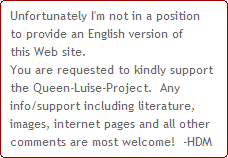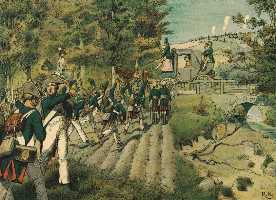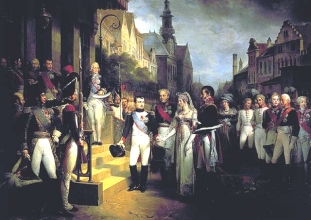 |
 |
|
Luise’s father served as governor of the English crown in Hanover, he later became the Duke/Grand-duke of Mecklenburg-Strelitz. Luise (or Louise, or Louisa as she is called
in the English speaking countries) had two surviving older sisters, Charlotte and Therese, and a younger sister, Friederike, as well as a younger brother, Georg. The relations
within the family was always harmonic, especially between Luise, Friederike and Georg.
|
|
 |
 |
|
Luise’s mother died in childbirth when Luise was six. Her father married her mother’s sister, who also died in childbirth. Therese, Luise and Friederike were sent to
Darmstadt, to live with their grandmother “Princesse George”. Luise and Friederike (Frederica) grew very close. They both were very attractive. Prince Karl took the
two girls to Frankfurt, were the election of the Emperor took place on 5 July 1792.
|
|
 |
 |
|
 |
 |
 |
|
The coronation ceremonies in Frankfurt were managed by Count Metternich, who danced with Luise again and again at the ball. Father Prince Karl was pleased to show off his two
marriagable daughters. - On 13 March1793 Luise, Friederike and their grandmother went to the French theater in Frankfurt were they were presented to King Friedrich Wilhelm II.
from Prussia, who was impressed.
|
|
|
|
On 7 October 1794 Luise gave birth to a girl, which was born prematurely dead, after Luise fell down a stair. On 24 October 1795 Luise gave birth to Crown Prince Friedrich Wilhelm
(IV.). The Crown Prince’s brother, Ludwig, died on 28 December 1796, leaving behind a widow, Friederike, with three children and not yet 20 years of age.
|
|
|
|
Luises education was not outstanding, she wasn’t prepared to become the reigning Queen of Prussia. She liked dancing, fashion, easy living, art. Luise’s change towards
a more political Queen was developing slowly. She was concentrating on her husband, whom she always called “my dear friend”. Luise probably knew, she was Friedrich
Wilhelm’s sole friend.
|
|
|
|
At the beginning of the 19th century Napoleon moved steadily into imperial ways. On 2 December 1804 Napoleon crowned himself Emperor of France. Russia, after breaking relations
with France, signed defense pacts with Austria and with England, France’s archenemy. Friedrich Wilhelm III. and Luise, who did not want war, tried to maintain
Prussia’s neutrality.
|
|
|
|
A French envoy who had come to Charlottenburg Palace, was trying to receive from him a guarantee of peace. At the same time Alexander I. announced mobolization and was calling on
Prussia to do the same. On 6 September 1805 Prussia declared partial mobilization, for the protection of the Prussian neutrality.
|
|
|
|
On 2 December 1805, the first anniversary of his coronation, Napoleon won the victory of Austerlitz, which is considered the most brillant of his career. The Prussian army was
willing to fight, but the King was not.He sent General von Knobelsdorf as an envoy to Napoleon, without the slightest success. Napoleon said:
|
|
|
|
The double battle of Jena and Auerstedt, which took place on 14 October 1806, has been described in the historical literature as the definitive defeat not only of the Prussian
army, but of the entire Prussia. The army had dissolved and banished running back toi Berlin. The Queen fled to Berlin and later to Schwedt where she met her children. Prussian
troops could not defend Berlin, and if captured, the Queen would be held as prisoners of war.
|
|
|
|
The children have been travelling with their aunt Friederike and their cousins. Luise sent a letter to Friedrich Wilhelm, telling him not to make a shameful peace, not knowing that
the King already proposed to negotiate peace conditions with Napoleon. Luise met her husband at Kuestrin.
|
|
|
|
All Prussian resistance came to an end. Luise and her family fled to Danzig, Ortelsburg, Koenigsberg. She and the children fell sick. Day by day the French drew nearer. The
children were sent off to Memel, the eastern-most part of Prussia. The Queen, being ill, decided to travel the strenuous winter
travel to Memel - Better in Gods hands than in the hands of Napoleon, she said.
|
|
|
|
Generous to Alexander I., Napoleon was merciless to the Prussian King. Prussia was reduced to half of its original size. It was forced to close its door to trade with England and
to join in war on England if called upon. Heavy indemnity had to be paid (the exact amount of money has been left open in the treaty), and the whole country was occupied by French
forces. Alexander, who was happy with the outcome of the Tilsit peace treaty, he did nothing to comfort Prussia’s position, but he continued to speak friendly with Luise and
Friedrich Wilhelm III. It took a long time until Luise realized that she has been betrayed.
|
|
|
|
Luise was forced to negotiate peace conditions with Napoleon, when decisions were already taken. Napoleon didn’t change his standpoint. Prussia was almost deleted from the
map and had to pay tremendous contributions. Napoleon was at the peak of his global power.
|
|
|
|
When Prussia reached its low point, it was the Queen who stipulated the change. She influenced the King, who was always weak in his decisions, to fire incompetent advisors and to
hire reformers like Freiherr vom Stein and Hardenberg. Within two or three years Prussia changed from the backwardly feudalistic state to a modern, almost democratic state.
|
|
|
|
Queen Luise, born in 1776, gave birth to 10 children. When she died in 1810, at the age of 34, she left a mourning country behind. Many stories were written about the Queen, many
paintings were painted, and she became the most popular idol during the ongoing liberation war, which was finalized with Napoleons defeat in the year 1815. Even after the victory
of La Belle-Alliance (Waterloo), Louise continued to be Germany’s legendary queen. Unfortunately people forgot her political achievements - can this Web site do justice to
the Queen?
|
|
|
 |
|
|
|
 |
|
|
 |
 |
 |
 |
 |
 |
 |
 |
 |
 |
 |
 |
|
The King made a visit to the girls grandmother in Darmstadt. Soon after the Crown Prince Friedrich Wilhelm (Fritz) proposed to Luise, and she accepted, and his brother Ludwig
(Louis) proposed to Friederike. The double wedding was set for December 1793. Luise was 17 years old, where Friederike was only 15. Grown up in south-western Germany, in an
open-minded environment, it was not easy to become a member of the Hohemzollern family. Distrust of new relatives was quite usual.
|
|
|
On 22 March 1797 her second son, Wilhelm, was born, who later became King of Prussia and German Emperor Wilhelm I. On 16 November died King Friedrich Wilhelm II. and Friedrich
Wilhelm III. became King and Luise became Queen of Prussia.
|
|
|
The King’s character has been described as undecisive, cagey and uncommunicative. His problem was not only not to have any friends, in addition to that he was always chosing
stupid and incapable advisors, and he was prepared to accept their advise. At that time, Luise became the only competent advisor to the King of Prussia.
|
|
|
France, Russia and Austria who increased the pressure towards Prussia, were making demands. It was during this period that Luise became convinced that Napoleon, whom she had
admired, must be defeated and that Friedrich Wilhelm should take a more resolute attitude. On the 25th of August 1705 French troops began to move eastward toward the Rhine.
|
|
|
The King went to Paretz for their customary holiday. He said, “Many a King has fallen, because he loved war too well, I may fall because I love peace.” On 3 October
1805 French troops invaded Ansbach, which was Prussian territory. On 3 November 1805 a treaty was signed between Russia, Prussia and Austria.
|
|
|
“Not a single French unit will be withdrawn from Germany until there was peace with Russia. Prussia must lay down her arms. A southwards advance of her army would be
considered an aggression.” At that time Prussian troops had already crossed the border of Saxony, Prussia’s ally.
|
|
|
 |
|
|
|
13 October 1806. The Queen visits the troops
|
|
|
|
When Napoleon arrived at Potsdam, he went to the tomb of Frederick the Great, he saud “If he would be alive, I would not be standing here.” Napoleon was an admirer of
the old Fritz. He made himself home at Charlottenburg Palace, were he searched Luises correspondence. He used what he found for insults being published in the Bulletin to the Army
and in the Moniteur.
|
|
|
Luise arrived at Memel three days later. She recovered and regained her strength. On 15 June the Russians (with some Prussian remnants) were defeated at Friedland near Koenigsberg,
the old East-Prussian capital. Alexander I. who didn’t want to have French troops in his own country, was asking for truce, which was granted. The French Emperor went to
Tilsit to make peace.
|
|
|
The talks on the river Njemen/Memel between Alexander and Napoleon went so bad for Prussia that Friedrich Wilhelm, who never wanted the war, asked Luise, who was pregnant, to come
and meet with Napoleon. Luise met with Napoleon. On that day Luise looked truly beautiful. She impressed the Emperor, she went so far to even humble herself and begged for mercy
on behalf of the Prussian people. Napoleon didn’t change his mind, he remained steadfast. After these talks he stopped his insulting campagne. Napoleon said to Alexander
“The Queen of Prussia is very charming. One would like to lay a crown at her feet instead of taking it away.”
|
|
|
 |
|
|
|
Napoleon, Alexander I., Luise and Friedrich Wilhelm III. 6 Juli 1807 at Tilsit
|
|
|
|
Queen Louise a steel magnolia?
Read more about this aspect.
|
|
|
|
|